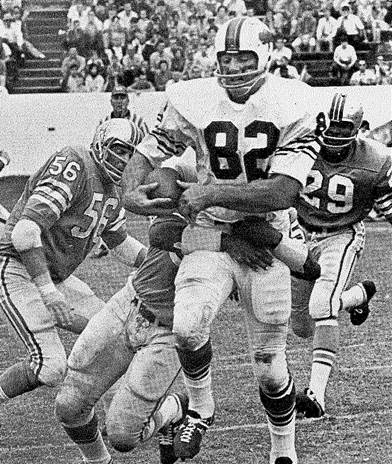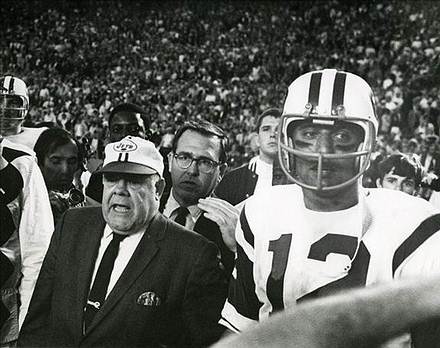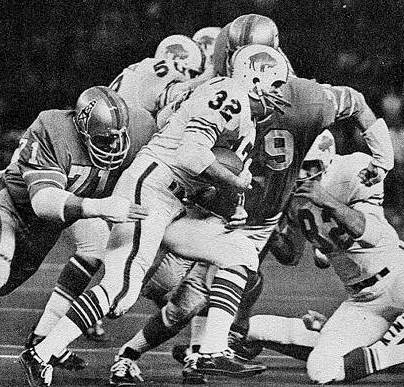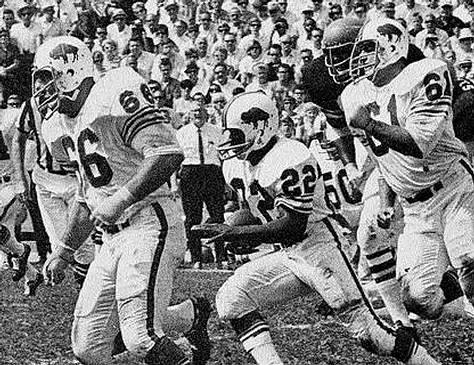

THE 1968 BUFFALO BILLS
HELMET HUT NEWS/REFLECTIONS March 2015:
THE 1968 BUFFALO BILLS
By Dr. Ken
The Buffalo Bills have one of the most loyal fan bases in the nation and in the absence of a playoff appearance in fifteen seasons, they need to. There was a time when the Bills were feared, especially their defense. The majority of Bills and NFL fans who know a bit about history, no doubt immediately place their thoughts upon the Bills teams that ascended to four consecutive Super Bowls. Although these terrific teams lost, no other modern day National Football League team can claim four consecutive appearances and those 1990 through ’93 seasons are certainly a high water mark in Bills’ history. The successful years continued through 1999, with playoff appearances in 1995, ’96, ’98, and 1999. Unfortunately, the well has been dry since and that era’s heroes like Jim Kelly, Thurman Thomas, Cornelius Bennett, and Mark Kelso are long out of their uniforms.
For older fans, the glory was perhaps greater in the 1964 and ’65 seasons when the Buffalo Bills won the American Football League Championship. By 1965 the AFL crown was seen as a prestigious reward for a hard fought season rather than a throw-away accolade in a lesser league. That the Bills did it in what was considered to be “National Football League style” with a ferocious defense and ball control offense made many fans who were either previously negative or neutral towards the AFL, take very positive notice. Bills linebacker Mike Stratton’s December 26, 1964 championship game tackle on the San Diego Chargers Keith Lincoln gained the moniker “The Hit Heard ‘round The World” in Buffalo’s 20-7 victory. The 1965 team underwent a number of changes but still featured defense with a capital “D” and a hardnosed attitude. The Chargers, who were always a dominant and offensively strong team in the first years of the AFL, were convinced that the Bills had won on a fluke in ’64 and were very much determined to beat the Eastern Division Champions soundly on their home field. San Diego was again on the short end of the title game score, this time in a 23-0 conquest by Buffalo. Despite the departure of head coach Lou Saban prior to the 1966 season, the Bills just missed out on a Super Bowl I appearance after losing to the Kansas City Chiefs 31-7 in the AFL Championship Game.
 |
Bills TE Paul Costa was a tough performer and played the latter part of his career as an offensive tackle
The wheels began to come off the wagon in ’67 as injuries and age began to catch up to the Buffalo contingent and the 4-10 final slate reflected that. This proved to be the team’s worst record to date as an AFL franchise yet the fans continued to be among the most supportive across the NFL and AFL. They saw the positive in Keith Lincoln’s first season as a Bill with his team leading 1159 rushing yards. They saw the injuries to receiver Art Powell, running backs Bobby Burnett and Lincoln, and great guard Billy Shaw which required a shuffling of the offensive line that would have made a Las Vegas casino owner proud. They were less critical than the press which noted that “Buffalo’s offensive unit sometimes plays as if an invisible shield had been constructed across the opposition goal line.” In ’67, the Bills failed to score a touchdown in fourteen of the season’s first fifteen quarters and it would have been difficult to ignore the offensive failings. Only the defense continued to battle successfully and the 1968 pre-season predictions were summarized with the comment that “Buffalo’s good defense should enable the Bills to finish third again, but the team is absolutely arthritic when it has possession of the ball, despite such stars as split end Art Powell, guard Billy Shaw and halfback Keith Lincoln.”
The author, as a fan of the
American Football League,
has been well versed in the
history of the Bills because
I was fortunate to be old
enough to witness all of it
as a teenager and young
adult. I was however, quite
surprised and extremely
impressed that new Buffalo
Bills head coach Rex Ryan,
quite a bit younger than me,
knew and appreciated the
history of his team as well
as I did. Fortunate enough
to recently spend time with
Coach Ryan, it was less the
championship years of 1964
and ’65 that had made an
impression on him than it
was 1968. Ryan’s father,
James David “Buddy” Ryan is
best known as the defensive
coordinator and architect of
the great Chicago Bears
defenses of the mid-1980’s
that took the Monsters of
The Midway to their Super
Bowl victory but fewer fans
know him as a significant
contributor to the 1968 New
York Jets team that altered
the course of football
history.
 |
NY Jets Defensive Line Coach Buddy Ryan giving sideline advice to Head Coach Weeb Ewbank as Joe Namath surveys the action
As a former high school and
college coach, Buddy’s first
season in the professional
ranks was the ’68 season,
serving as the Jets
defensive line coach. As
much as his actual coaching
of technique and scheme, the
elder Ryan coached attitude
and motivation and of
course, the Jets victory
over the heavily favored
Baltimore Colts caused a
shift in attitude towards
the AFL and its acceptance
among most football fans.
Because it was his father’s
first season as a
professional coach, as an
AFL coach, and as a
championship team coach, the
1968 season has become a
touchstone for Rex Ryan.

Running back Gary
McDermott of Tulsa
University wore number
32 for the Bills in
1968, later ceding it to
OJ Simpson
Going into 1968, Bills Head
Coach Joel Collier was
confident the team would
rebound. Quarterback Jack
Kemp had deteriorated in
’67, both statistically and
physically, but he was still
the team leader with
seasoned ability at age
thirty-three. No one could
be sure if running back
Bobby Burnett would recover
from his serious knee injury
and when exposed to the
expansion draft, he was
taken by the new Cincinnati
Bengals. However, six of the
Bills first seven draft
choices for ‘68 were
offensive players and
included first round pick
Haven Moses, a talented
receiver out of San Diego
State who paid off with an
AFL All Star Game appearance
in ’69. With stalwart backs
Wray Carlton and Lincoln
aging, Arizona State’s Max
Anderson and Nebraska’s Ben
Gregory were tapped to be
the new young wave. The
defense was expected to play
at its usual tough,
effective level. Ron McDole,
Tom Sestak, Jim Dunaway,
Harry Jacobs, Paul Maguire,
and John Tracey were
respected veterans.
Defensive back Tom Janik had
tied for the lead in the AFL
with ten interceptions in
‘67 and was surrounded by
Butch Byrd, Booker Edgerson,
and George Saimes. Collier
predicted that ten or twelve
rookies would make the final
roster and they did but the
1968 season proved to be the
worst ever for the Bills,
ending with that inglorious
1-12-1 mark.
Rookie Max Anderson, running
behind the great Billy Shaw,
was a solid rookie in the
disastrous 1968 season
The reasons were many and
because the Bills were
division rivals of the Jets
his father coached for,
Coach Rex Ryan knew that a
combination of age,
injuries, six rookie
starters, and a number of
poor coaching decisions
produced a season that could
only be described as a
disaster. After losing the
first two games of the
season, the second a
September 15th, 48-6
whipping from Oakland, Head
Coach Collier was fired.
Harvey Johnson was elevated
to the head spot but he was
actually a personnel
administrator and negotiated
quite a few of the contracts
with the current Bills
players. This made for an
uncomfortable situation that
was made worse when other
assistants quit and
replacements were quickly
brought in. Thus, replacing
the head coach and a third
of the existing staff after
two games, Johnson could
manage only a victory and a
tie in the season’s
remaining games. Ironically,
that victory was a 37-35
upset over Buddy Ryan’s
Jets! If there was a
positive aspect to the ’68
season, it allowed for the
first pick in the 1969 draft
and placed the Bills in
position to acquire OJ
Simpson. The ’69 season’s
record of 4-10 was far from
a rousing success but
certainly an improvement
over 1968 and the foundation
was started for the terrific
rushing attack of Simpson
and The Electric Company of
the effective 1973 through
’75 squads.
His appreciation for
football history and
especially that of the
American Football League was
complete and impressive. I
was pleasantly surprised
that when examining the
iconic Robert L. Smith
photograph of Stratton’s
1964 Championship Game
tackle, Ryan immediately and
accurately identified every
player in the photo,
including those buried in
the background. Of course,
1968 was one of those Bills
seasons that was perhaps
better forgotten once it
reached its conclusion as a
1-12-1 catastrophe. Yet this
was a signature season for
Coach Rex Ryan.
